MZUNGU – “Man Without Skin”
Center of Africa, Rwanda
9X0A (RW3AH) 1997-1998 ©
Andy Fyodorov
A Notice of the second Rwanda expedition arrived unexpectedly, leaving me very little time to prepare for the trip. The morning of departure found me and my family gathered at the breakfast table. While my wife Nadia and I discussed last minute details, my young daughters planned excitedly for gifts Daddy should bring them from Rwanda: a monkey and a parrot!
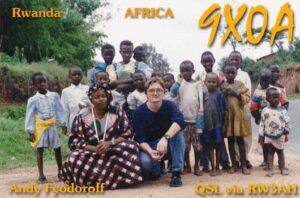 On August 22, 1997, the Minister of Emergency Situations And Civil Defense of Russia (EMERCOM) notified me and three co-workers to prepare to leave for Rwanda immediately. Passports and other travel papers were arranged that same evening. Communication equipment we needed to make repairs had been sent ahead, and was already waiting for us in Rwanda. In any event, I had prepared to take with me an emergency set of equipment: a hand-held VHF radio “FT-51RH” with a spare batteries and charger, an HF transceiver “IC-706” with an “AT-180” antenna tuner, HY-GAIN Multi-band Dipole (3-30 MHz) and a KAM-7plus TNC. This emergency kit weighted between 10 and13 Kilos!
On August 22, 1997, the Minister of Emergency Situations And Civil Defense of Russia (EMERCOM) notified me and three co-workers to prepare to leave for Rwanda immediately. Passports and other travel papers were arranged that same evening. Communication equipment we needed to make repairs had been sent ahead, and was already waiting for us in Rwanda. In any event, I had prepared to take with me an emergency set of equipment: a hand-held VHF radio “FT-51RH” with a spare batteries and charger, an HF transceiver “IC-706” with an “AT-180” antenna tuner, HY-GAIN Multi-band Dipole (3-30 MHz) and a KAM-7plus TNC. This emergency kit weighted between 10 and13 Kilos!
The stay in Africa was to be a long one, from August 1997 through February 1998. The maintenance of the EMERCOM communication equipment would take place in uncivilized conditions high in the mountains Central Africa where there is much political instability. The responsibility of a successful trip was laid squarely on me.
The flight was long and tiring. From Moscow we flew to Zurich, Switzerland, where we laid over for 8 hours beforecq EU from 9X boarding a Boeing jet for the final leg to Nairobi, Kenya. We traveled to the capital of Rwanda in Kigali early in the morning where we were met by the EMERCOM advance team that had arrived in Rwanda previous April. We traveled a long distance by Land-Rover heading south, arriving at our destination located close to the equator, an area where the borders of Burundi, Zaire and Rwanda meet.
Rwanda is approximately the same size as New York State and is mountainous, with an average altitude of 1500-2000 meters above sea level. Our compound, located at about 2400-2500 meters above sea level, provided us with an impressive panorama of the surrounding mountains, all densely covered with lush vegetation. Except for the real and dangerous presence of diseases such as malaria and AIDS, Rwanda reminded me of Switzerland.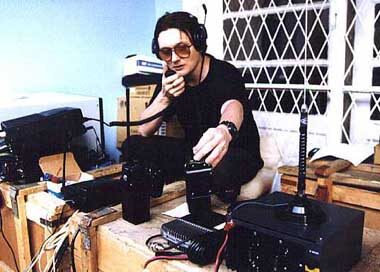
In Rwanda, there is no such thing as the four seasons. The rainy season is from September through February, which is followed by the dry season. In spite of the high altitude, there is no snowfall. Most days begin and end with the hot African sun shining relentlessly down from a cloudless pale blue sky. There are occasional rainstorms, but too few to mention.
“MUZUNGU” is Rwandan for “a man without skin” (meaning me!). The locals joked about me becoming “carbonized.” More than once I suffered from the painful effects of “carbonization” after too much exposure to the harsh African sun.
Danger presents itself in the most unexpected ways in Rwanda. Lie down under a particularly attractive, red-leafed tree to escape the day time heat and you can almost guarantee yourself a trip to the hospital! Known to the locals as “death of the white person,” the tree induces some sort of allergic reaction. Fortunately, there aren’t a lot of those trees around.
Engrossed in thought, you may not notice a small mosquito feasting on your blood — not until later, when malaria sets in. Or walk barefoot across the grass and receive a form of “fellarioz,” an invasion by microscopic parasites that devour humans from within. Stroke one of the many varieties of fluffy African caterpillar and you may end up with a raging allergic reaction!
The local population in most cases is immune to these disorders. To them, malaria is like an minor cold, but MUZUNGU is not so fortunate!
We were so busy with work, we were unable to see much of the local sites in Rwanda. However we were able to visit the palace of the former Rwandan King, now a memorial for the victims of the 1994 genocide.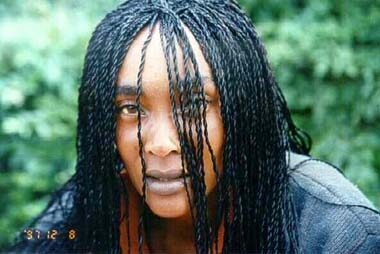
The inter-tribal conflicts between the Huttu and Tutsi in 1994 resulted in the tragic extermination of approximately two million people, including many of the adult males, leaving behind a population consisting mainly of young people. Only peacekeepers of international forces brought a halt to this bloody war.
Both birth and mortality rates in the region are rather high. Few manage to live past age 50. Families commonly average 5 to 8 children each.
The Rwandan army consists of young volunteers who serve their entire lives. Most of the population is extremely patriotic, even to the point of fanaticism. The people are hardworking and good-natured. Main language of the country is Keni-Rwanda, and the official one is French. The country is agrarian and the majority of the population is engaged in agriculture growing coffee, bananas, potatoes and other African exotic foods.
After our first six months of work in Rwanda much had changed. Nothing happened there in April. Now at the entrance to our camp a separate field mast showed off in all its beauty a triband HY-GAIN “TH-3mk4” Yagi antenna. It has withstood all the foul weather successfully, including a tornado!
Our residential complex consisted of a store building, a 9X0A radio room and the equipment room that contained various other communication equipment (HF, VHF, satellite, amateur and office equipment; two computers; a copier, fax machine and a laser printer). Outside there were antennas nearby, consisting of the previously described short-wave three-element Yagi, and also a VHF collinear Cushcraft Ground plane antenna. Located between two high trees a was broadband dipole stretched for HF communications (similar to a “T2FD”) with a passive load, and two independent aerials on 40 and 80, the “Inverted V” type. (Incidentally, the Hy-Gain antenna on 80 meters worked really well though a major fault appeared to be a very narrow frequency range of only 10-15 kHz.)
Among all this equipment in radio room was a special place for a Yaesu HF “FT-900” transceiver with a “FP-800” power supply unit, a “2KD Classic” 1.5 kW amplifier by Henry Radio. On the first visit I conducted more than 10000 QSO using 9X/RW3AH callsign, and on the second visit, operating for two months with new 9X0A call – for which I waited for six months — more than 17000 QSO were made, representing over 150 countries of the world. Very little remained to work on 40 and 80 to complete a “5BDXCC” award.
All this was of the time I wrote this article. Obviously, by the end of this mission, the number of QSOs and countries will be much higher.
The story about getting the amateur license in Rwanda would take hours and needs a separate narration, as it isn’t all that interesting. The red tape lingered for six months, as I already noted, and has taken a lot of my time. I am thankful to the representatives of the Embassy of Russian Federation in Rwanda and to the local authorities for their assistance.
The equipment performance surpassed all of my expectations. The HF propagation here differs a lot from that which we usually notice in a Central part of Russia. 20 meters band is saturated with stations from all continents practically around the clock. Only in the middle of a day or early morning does it slightly dip. The peak of propagation is during the evening, when the stations of Japan, the USA, and especially of Europe come in loud and clear. In one evening I conducted the original experiment. During a pile-up on 20, I periodically interrogated stations of all continents. It felt very strange to receive identical reports of “59” from all over. It was highly amusing to hear stations of Oceania fighting the pile-ups with stations of Europe, Northern, Central and South America. A discussion of propagation found in Central Africa follows.
160m. band – Because I didn’t have an antenna for this band it was hard to do an objective evaluation there. Sometimes, on the 80 meter antenna in the middle of the night I could hear audible signals coming from Ukraine and Russia.
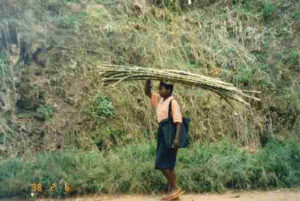 80m. band – The band opens up at approximately 19 GMT. The short path opens to Australia and Japan (approximately for an hour), sometimes, the stations from Europe would come in with booming signals, mostly Big Guns. At 21 GMT the band opens up to North America, and soon after – to Central and South America, including the Caribbean. The reception is difficult because of the ever-present noise from the equatorial thunder-storms – QRN year round. By morning a band becomes quieter, but not by much. Decent strength signals from Africa, North and Central America can be heard. By this time my correspondents, as a rule, can no longer hear the Central part of Africa. It is my impression that path unilateral. Europe ceases to answer my calls, and the US signals are very faint.
80m. band – The band opens up at approximately 19 GMT. The short path opens to Australia and Japan (approximately for an hour), sometimes, the stations from Europe would come in with booming signals, mostly Big Guns. At 21 GMT the band opens up to North America, and soon after – to Central and South America, including the Caribbean. The reception is difficult because of the ever-present noise from the equatorial thunder-storms – QRN year round. By morning a band becomes quieter, but not by much. Decent strength signals from Africa, North and Central America can be heard. By this time my correspondents, as a rule, can no longer hear the Central part of Africa. It is my impression that path unilateral. Europe ceases to answer my calls, and the US signals are very faint.
40m. band – Starting with approximately 16 GMT it is possible to work somebody. At this time the path opens to Europe, Russia and QSLJapan. Some correspondents like UA9AJ can be heard in 9X with a level 59 + from 15 GMT on. It’s all depends on the antenna. By night the band is busy with Europeans. Japan and even of Oceania are coming in with the same signal strength. At midnight the path sharply changes in the direction of North and South America. American signals are a pleasant surprise, especially in SSB. Operating split allowed me to run huge pile-ups. At one o’clock it is sometimes possible to work 160, mostly with the USA. By morning the band folds, though South America continues to come in faintly. An amazing number of radio stations was worked from many South American countries. There was a moment
when about 50 stations from Paraguay called in at once. During the day this band becomes a local band. There is a large number of commercial radio stations operating phone there. Their signals aren’t loud, as most of them operate as mobiles. Mostly, these belong to international missions and Red Cross workers driving their “Land-Rovers” somewhere in Africa. They can be heard from every corner of the African continent.
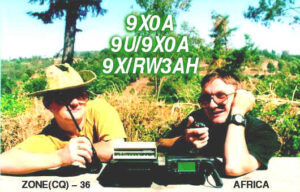 20m. band – As I noted earlier, the band is opened around the clock to most parts of the world. The openings are stronger in the evenings, at 18 GMT the Europeans are booming in with an Arctic flutter, much like American signals in the European part of Russia coming through a polar cap. It is difficult to say what brings about this phenomena. Perhaps, this is something that is caused by local conditions. The openings are tremendous, extending from the northern tip of Alaska to the south-most point of Cape Horn. In the morning, at approximately 4 GMT Long Path to VK/ZL and Oceania opens up. During the day the band is appreciably worse, but it does not fold. Europe can be heard, but n
20m. band – As I noted earlier, the band is opened around the clock to most parts of the world. The openings are stronger in the evenings, at 18 GMT the Europeans are booming in with an Arctic flutter, much like American signals in the European part of Russia coming through a polar cap. It is difficult to say what brings about this phenomena. Perhaps, this is something that is caused by local conditions. The openings are tremendous, extending from the northern tip of Alaska to the south-most point of Cape Horn. In the morning, at approximately 4 GMT Long Path to VK/ZL and Oceania opens up. During the day the band is appreciably worse, but it does not fold. Europe can be heard, but n
ot loud. At this time they don’t hear me very well. Some days, more an exception than the rule, the short path is closed. Fortunately, it’s a rare occasion.
15m. band – This is the best African band, together with other conventional bands and WARC 17 meter. The openings last from morning until late evening. The band is similar to 20 meter band, but is not subject to QRN and QSB. The US stations are worked in the afternoon. The stations of Oceania and Japan prevail first half of the day. Europeans can be heard all day and evening with decent signals.
10m. band – I have developed an impression that this band is always alive. From morning till late at night one can hear QRM from CB stations on all frequencies in this band. I could not determine where the signals were coming from, because I did not understand the language. However, without a doubt it was coming from South East Asia. Not enough ham stations are operating there. Because of that one might think that the band is closed. It is necessary to call CQ to open up the band. Some nights, starting at 20 GMT, the band is a busy beehive of North American stations. All this is during the period of minimum solar activity! Interestingly enough, there is a band opening to the European part of Russia at this time, but as a rule most Russian hams are either fast asleep or conducting 80m contacts among themselves.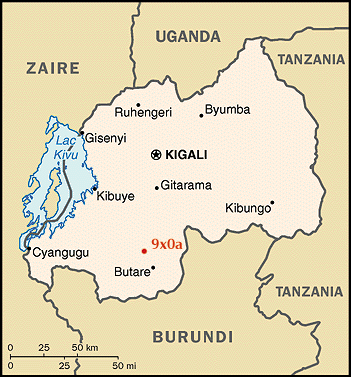
CB- 27 MHz. – My simpathy goes to the fans of this band. Strangely, this band is always open. The wall of QRM never ceases. I am no expert in the field of CB communications.
Together with the time spend playing radio, I was involved in the round tables of the Russian Amateur radio Emergency Service (RARES), on 14.292, at 07, 14 and 19 GMT. It was necessary for several reasons. The chief concern was for the safety of our staff in Rwanda, an area of increased risk. Political situation in the country is far from stable. Therefore telecommunications remain the most basic element of safety for missions similar to ours. The Amateur Radio channel of communications was and is a unique way to disseminate important information in case of extreme emergencies for EMERCOM of Russia. RARES closely cooperates with EMERCOM, starting from our involvement with the rescue work after the Armenian earthquake in 1988.
Never throughout my stay in Africa had I failed to make contact with the members RARES round table, it was that reliable and selfishless work by the regional coordinators of RARES – RA0AF, UA9SH, RN6AA, RU3ABD and auxiliary members who, at any time, frequently to the detriment to their own lives, are ready to extend their helping hands to others. RE0A, RK6AZR, RZ1AWE, RA3AK. RA3AR, UA9HEZ, UU1JD, RX9AV, RU3AO, RK3AH, RK3AO, RK3AZ, RU3AG, UA6ADV, UA6CL, RK3ZZZ, UA3BT, and many others. Thank you all for you help and invaluable support!
From the beginning of my African tour I tried to enter as many contest as my time allowed. Unfortunately, in the CT-K1EA contest program was missing many tests, and I didn’t have another piece of software available. I had to operate and later modify report manually. I also used CT for my daily logging. It worked great for both SSB and CW, and I was very happy with the conveniences and reliability it offered.
I have fond memories of the RTTY WW DX Contest, which I operated successfully, even though I had my official duties to attend to. I had conducted more than 700 QSO and earned about 500K points. For many – 9X isn’t only the long-awaited multiplier, but new
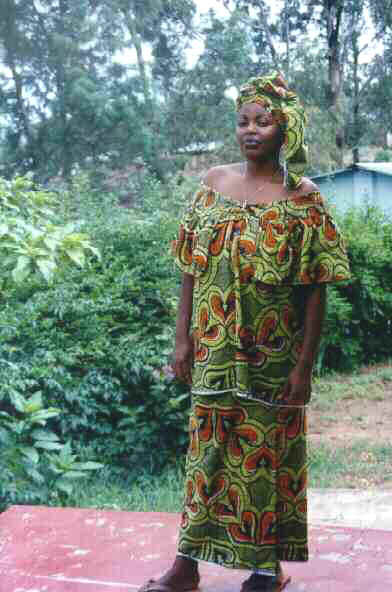 country for DXCC. Most of my equipment survived the strenuous contest conditions. Only my Henry 2KD Classic failed me once – an antenna relay went.
country for DXCC. Most of my equipment survived the strenuous contest conditions. Only my Henry 2KD Classic failed me once – an antenna relay went.
With an unpleasant surprise had I discovered that this particular brand of relay really wasn’t designed to handle hi-power HF currents. Ultimately that relay was most susceptible to failure in my entire communication setup. I had to circumvent the problem temporarily, by using an extra receiving antenna.
There was no way to purchase such a relay, or something functionally similar in this part of Africa. The friends to the rescue! Harry – RA3AUU, sent a relay using Express mail viaMy QTH the US and I got it in Rwanda. Almost at the same time, Vladimir, RA3AK collected a small parcel of various radio parts and sent them through RU3ABD and representatives of “EMERCOM” of Russia. For that I am very grateful to all of them. The problems associated with equipment are quite natural, when the equipment is utilized to its fullest potential.
It was also necessary to establish a way communicate on digital modes, to pass along personal messages and to make amateur contacts. This wasn’t difficult to do – I brought a packet controller. By evaluating my present operating conditions and by listening to the local airwaves I have concluded that the most reliable way to do it would be PACTOR. My first regular BBS on 20m. was – ZS5S, 9K2EC. For my packet communications an invaluable assistance was provided by UA6CL from Novorossijsk. However, the packet channel of communication wasn’t very stable due to local QRN, and weak signals from UA6CL’s BBS in central Africa. A most unexpected opening allowed me access into the digital PACTOR in Belgium – ON5FS. This afforded me access into European packet network. PACTOR communications through ZS5S BBS permitted E-mail message exchange via Internet access point in South Africa. My experience in the field of packet communication from Russia was very useful in Africa.
It probably snows in Moscow by now. The first channel of the Russian TV network, which we regularly watch here via satellite brings less than consoling weather forecasts. It is cold over there. In August, when I left early morning from Moscow “Sheremetyevo-2” airport and was seen off by Ark -RK3AZ, and Peter – RU3ABD, I was dress in some very summer-like clothes. It didn’t occur to me to bring some warm garments. How stupid of me! Now I would be very sorry to return home to February frosts!
73 de 9X0A (RW3AH)
Copyright © Andy Fyodorov, RW3AH (9X0A-KL1A)
All rights reserved.
